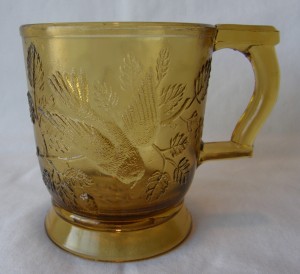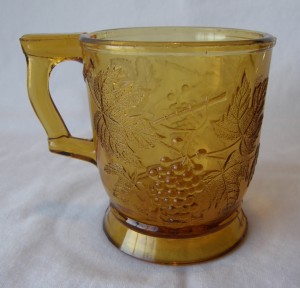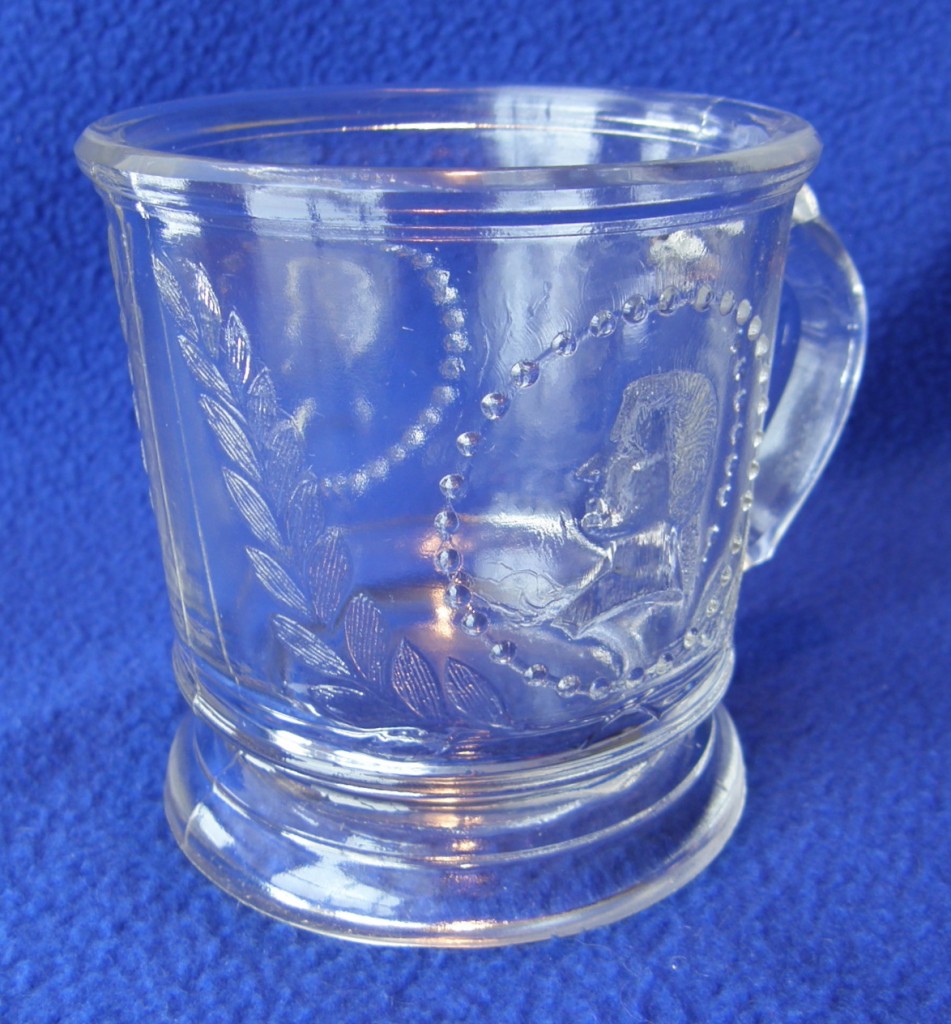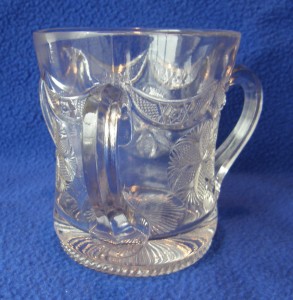These beaded handle mugs form a four-size set. I have five of them, two of the Bird on a Branch design which is the second-largest of the set.

Bryce Beaded Handle Seat
Bryce Brothers made these mugs in the 1880s at a time when the company may have been known as Bryce, Walker & Co. In 1891 Bryce joined other glass manufacturers to form U.S. Glass Co. and became known as “Factory B” of that concern; it continued manufacturing these mugs, apparently for another 20 or more years. They were made in clear, frosted, amber, opaque white, and blue. All of the mugs have beaded handles and pleated skirt bases.

Dog Chasing Deer (3-1/4" dia. x 3-3/4" ht.)
is the largest mug in the set. It measures 3-1/4″ in diameter and 3-3/4″ in height. To the right of this mug’s handle one sees a young stag looking back over its left shoulder. Directly opposite the handle there are a doe and two stags running from the dog further around the bowl of the mug. To the left of the handle one sees the dog chasing these deer. The animals are framed by trees. The mug was made in a three-part mold; the mold seams run up the trunks of the trees.

Dog Chasing Deer (3-1/4" dia. x 3-3/4" ht.)

Dog Chasing Deer (3-1/4" dia. x 3-3/4" ht.)
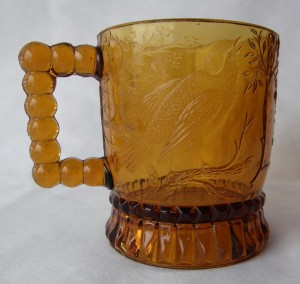
Bird on a Branch (2-7/8" dia. x 3-3/8" ht.)
The second largest mug in the set is
Bird on a Branch, which measures 2-7/8″ in diameter and 3-3/8″ in height. To the right of this mug’s handle is a perched bird on a branch; the bird is sitting upright and appears to be singing. Directly opposite the beaded handle, one sees as owl perched on a branch. To the left of the handle, the sculpting shows a crouching song bird perched on a branch. Like its larger companion, this mug was made in a three-part mold and, again, the mold seams are hidden in the trunks of the trees.

Bird on a Branch (2-7/8" dia. x 3-3/8" ht.)

Bird on a Branch (2-7/8" dia. x 3-3/8" ht.)

Bird on a Branch (2-7/8" dia. x 3-3/8" ht.)

Bird on a Branch (2-7/8" dia. x 3-3/8" ht.)
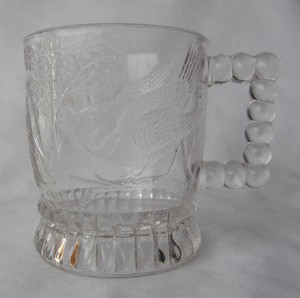
Bird on a Branch (2-7/8" dia. x 3-3/8" ht.)
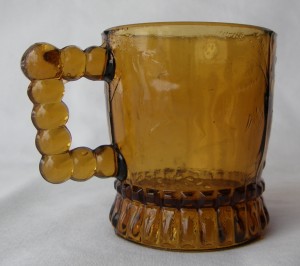
Pointing Dog (2-3/8" dia. x 2-5/8" ht.)
is the third mug in the set, measuring 2-3/8″ in diameter and 2-5/8″ in height. On the right side of this mug, one finds a hunting dog looking backward over its left shoulder. Opposite the handle there is a singing bird in a crouching position perched on a branch. To the left of the handle is another hunting dog looking straight ahead and pointing toward the bird. Like the two larger mugs, this one was made in a three-part mold and the seams are hidden in tree trunks.

Pointing Dog (2-3/8" dia. x 2-5/8" ht.)

Pointing Dog (2-3/8" dia. x 2-5/8" ht.)
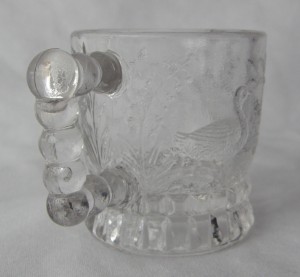
Swan aka Water Fowl, U.S. Glass No. 3802, or Federal's No. 3802 (1-7/8" dia. x 2" ht.)
(which is also known as
Water Fowl) is the smallest of the set. It measures 1-7/8″ in diameter and 2″ in height. It is seen in packers’ goods catalogs as U.S. Glass No. 3802 or Federal Glass Company’s 1914 Packers’ Catalogue as Federal’s No. 3802. Mugs (and other vessels) made as “packers’ goods” were used to distribute condiments and could afterwards be used for whatever purpose the consumer might choose. Often they were intended as toys for children, which was probably the case with this little item. (
Note: There are many mugs and other glass items featuring a swan motif. Another
Swan pattern, also known as
Plain Swan or
Swan with Mesh, was made by Canton Glass Co. circa 1882. There seems to be no mug associated with that pattern.
See Darryl Reilly and Bill Jenks,
Early American Pattern Glass: Collector’s Identification & Price Guide, pp. 443-44 (2nd Ed.: Krause Publications, Iola, WI: 2002) and Ruth Lee Webb,
Early American Pressed Glass, pp. 531-32 (36th Ed.: Lee Publications, Wellesley Hills, MA: 1960).)
On the right side of this little mug one sees a duck swimming among water grasses. Opposite the handle, a bird (either goose or duck) is taking flight from among the rushes. To the left of the handle, a swimming swan glides among the cattails. This mug also was made in a three-part mold; one seam line is well-hidden in the stem of a cattail, while the other is only partially obscured by a palm. My copy of this mug is marred by impurities within the glass: an arc of what seem to be ash particles is imbedded in the glass.

Swan aka Water Fowl, U.S. Glass No. 3802, or Federal's No. 3802 (1-7/8" dia. x 2" ht.)
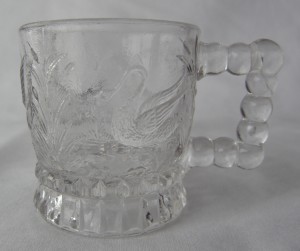
Swan aka Water Fowl, U.S. Glass No. 3802, or Federal's No. 3802 (1-7/8" dia. x 2" ht.)
The Carnegie Library of Pittsburgh provides this information about the Bryce Brothers Glass Co.
James Bryce, born in Scotland in 1812, migrated to the United States at the age of 5 with his family and first lived in Philadelphia before moving to Pittsburgh in 1819. At the age of 15 he was indentured to Bakewell, Page & Bakewell in 1827. James left the factory when it was temporarily closed by a Financial Panic in the 1830s, but returned to glassblowing in 1845 with the firm of Mulvany and Ledlie.
The firm Bryce, McKee and Co. was established by James in 1850 with his brothers Robert and John who were joined by the McKee brothers, Frederick and James. Their Factory was located at Wharton and 21st streets on Pittsburgh’s South Side. The McKee brothers withdrew from the company in 1854 to establish their own business and two new partners were brought into the company—Joseph Richards and William Hartley— who remained until 1865.
The Walkers who joined the partnership when William Hartley departed added their name to the firm which became known as Bryce, Walker & Co. until 1882 when the Bryce family sold their interest to U.S. Glass Co. which was known as Factory B. Three years later the Bryce Brothers reestablished their business in Hammondville where glass products were produced until 1896 when a new factory was built at Mt. Pleasant.
Bryce Brothers produced tableware, lamps, apothecary wares and bottles. Their pressed glass patterns—Roman Rosette, Ribbon Candy and Ribbed Palm or Sprig were well known as were patterns named Diamond Sunburst, Thistle and Strawberry for which design patents were secured.
Lenox Co. acquired Bryce Brothers in 1965.
The Glass Etch and Pattern Gallery provides this additional (and slightly conflicting) information about the company’s history (adapted from The Glass Candlestick Book: Volume 1, by Tom Felt and Rich & Elaine Stoer):
BRYCE BROTHERS COMPANY, Hammondville, Pa. (1893 1896), Mount Pleasant, Pa. (1896 1967). The involvement of the Bryce family in glass manufacture extends back to the early 1840s. The original Bryce brothers, James, Robert and John, founded Bryce, McKee and Company in Pittsburgh around 1850. After various changes of name, the company was reorganized as Bryce Brothers in 1882 – two of the original brothers, Robert and James, being joined by five of the latter’s sons, as well as one son of Robert’s. In 1891, Bryce Brothers became factory “B” of the United States Glass Company.
Most of the Bryce clan took positions with U.S. Glass. However, in 1893, two of the younger generation, Andrew H. and J. McDonald Bryce, withdrew to found the new Bryce Brothers Company. They purchased the bankrupt Smith-Brudewold Company’s plant at Hammondville, which they operated until 1896, when they moved to a brand new factory in Mount Pleasant. Their specialty was blown stemware and tumblers, with a full variety of offerings for the hotel and bar trade. From the beginning they also offered many forms of decoration, including etching, cutting, sand blasting, iridescent finishes, enameling, gold bands, etc. Bryce Brothers remained a major producer of blown stemware and tableware through most of the twentieth century. In 1948, they began using a logo that advertised “Bryce, hand blown, since 1841,” apparently referring to the year when the original John Bryce got his first job in the glass industry, working for Bakewells and Company. In 1965, Bryce Brothers Company was purchased by Lenox, Inc., the Trenton, New Jersey, china manufacturer, who continued to operate the factory under their own name until the 1990s.
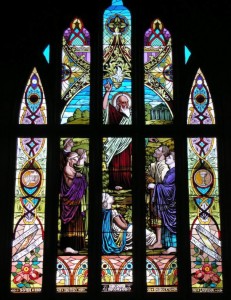 Lenten Journal, Day 32 – 5th Sunday in Lent
Lenten Journal, Day 32 – 5th Sunday in Lent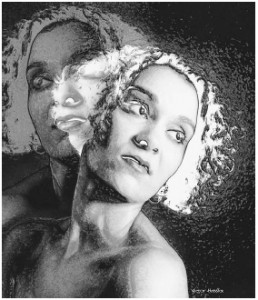 These may be my favorite words from the pen of the Apostle Paul. My mentor during my education for ordained ministry, who also became my first boss after ordination, often referred to these verses and would add, “Not even ourselves.”
These may be my favorite words from the pen of the Apostle Paul. My mentor during my education for ordained ministry, who also became my first boss after ordination, often referred to these verses and would add, “Not even ourselves.”


